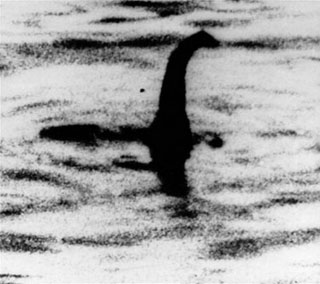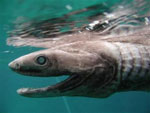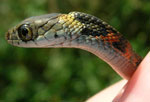BBC airs purported footage of Loch Ness monster
BBC airs purported footage of Loch Ness monster
mongabay.com
May 31, 2007
BBC Scotland has aired video footage of what a man claims to be “Nessie”, the mysterious creature rumored to dwell in the deep Scottish lake. While scientists have thoroughly rejected the idea that Nessie is a dinosaur surviving from prehistoric times, they allow that the Loch Ness could house unknown species of fish or eels that could be mistaken for the beast of legend.

The “Surgeon’s photo” (1934), the most famous picture ever taken of the monster was revealed as a hoax in the 1990s. |
Nevertheless, the thought of a lake-dwelling long-necked aquatic reptile attracts thousands of tourists to the site each year. Since the 1930s when the alleged bast was first captured on film (later revealed to be a hoax), there have been more than 4,000 unconfirmed sightings.
The new footage shows ripples caused by the apparent movement of a large object and possibly a “fin”. The timing of the sighting is opportune as a group of Scottish business owners launched a bid to nominate Loch Ness for World Heritage site status.
BBC Scotland
Related
 |
World's only blue lizard heads toward extinction
(3/7/2007) High above the forest floor on the remote Colombian island of Gorgona lives a lizard with brilliant blue skin, rivaling the color of the sky. Anolis gorgonae, or the blue anole, is a species so elusive and rare, that scientists have been unable to give even an estimate of its population. Due to the lizard&spod;s isolated habitat and reclusive habits, researchers know little about the blue anole, but are captivated by its stunning coloration.
 |
Giant squid use bioluminescence to hunt prey, communicate
(2/23/2007) The giant squid uses bioluminescence to hunt its prey, according to new deap-sea observations using a high definition underwater video camera system. The findings are published in the online edition of the Proceedings of the Royal Society B.
 |
Unusual prehistoric shark beast captured in Japan
(1/24/2007) A rare frilled shark was captured live by fishermen off the coast of Japan. The toothy eel-like creature was taken to Awashima Marine Park in Shizuoka where it later died according to Reuters. The 5-foot (1.6 meter) long beast was believed to be ill because it was found in shallow waters. Generally the species, known as Chlamydoselachus anguineus, lives at a depth of 488-4550 feet (150-1400 m). It is considered a primitive shark, largely unchanged since prehistoric times.
Rare coelacanth captured in Indonesia
(5/20/2007) An Indonesian fisherman caught a coelacanth, a species so ancient it is called a 'living fossil', off the coast of Sulawesi, Indonesia, according to the Associated Press. The fisherman managed to keep the specimen alive for 17 hours in a pool before it expired.
In search of Bigfoot, scientists may uncover unknown biodiversity in Malaysia
(2/1/2006) Malaysian scientists are scouring the rainforests of Johor state in search of the legendary ape-man Bigfoot, supposedly sighted late last year. But they are more likely to encounter some less fantastic but unique creatures that dwell in these still unexplored ecosystems.
 |
Balloon technology could cut cost of solar energy 90% by 2010
(2/21/2007) With high energy prices and mounting concerns over human-induced climate change, there is intense interest in renewable energy, especially solar, which produces no pollution and is readily available in the form of sunlight. In recent years, however, the solar energy market has been hampered by supply shortages of refined silicon, the critical resource needed for solar cell fabrication. Further, because solar installations traditionally require a large surface area to capture as much sunlight as possible, solar arrays often take up real estate, occupying land used agricultural production and other purposes. Without government subsidies, solar is not presently viable in many areas.
 |
Snake becomes poisonous by eating toxic frogs
(1/29/2007) A new study shows that the Asian snake Rhabdophis tigrinus becomes poisonous by sequestering toxins from its prey which consists of venomous toads. While sequestering defensive toxins from prey is unusual among terrestrial vertebrates it is not unknown. Research published last year by Valerie C. Clark of Cornell University showed that poison dart frogs (Dendrobates species) and their Madagascar counterparts, the Mantella frogs, sequester toxic skin chemicals, called alkaloids, from the ants they eat. These alkaloids protect the frogs from predation. Similarly, some garter snakes are known to store tetrodotoxin from ingested newts while birds in New Guinea appear to sequester poisons from insects.
 |
Why poison dart frogs are poisonous
(5/14/2007) Mites — not ants as long believed — appear to be the primary source of toxins used by poison arrow frogs to defend against predators, reports new research published in the early online edition of Proceedings of the National Academy of Sciences (PNAS). Poison dart frogs, colorful amphibians with skin secretions so toxic that they are used by indigenous populations to poison the tips of hunting arrows, are one of several groups of animals capable of sequestering deadly compounds from dietary sources without being harmed. Until now, it was believed that ants were the primary source of these defensive skin alkaloids in frogs.